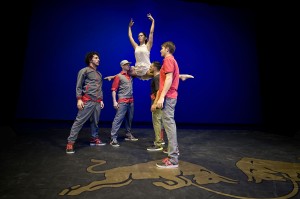 ASTANA – Germany’s most popular break dance crew, The Flying Steps, brought its latest show, a combination of classical music and modern street acrobatics, to Astana on Nov. 1 and Almaty on Nov. 3. The show, break dancing performed to the music of Johann Sebastian Bach, was held at the Palace of Peace and Accord and gathered a full house.
ASTANA – Germany’s most popular break dance crew, The Flying Steps, brought its latest show, a combination of classical music and modern street acrobatics, to Astana on Nov. 1 and Almaty on Nov. 3. The show, break dancing performed to the music of Johann Sebastian Bach, was held at the Palace of Peace and Accord and gathered a full house.
The 70-minute show depicts the complex synthesis of two completely different worlds: the high art of classical music and the urban art of break dancing. As pianist Christoph Hagel, artistic director of The Flying Steps, performs masterpieces by Bach, the break dancers and a ballerina try to find a successful formula of coexistence on the stage, going through challenges and tensions and finally breaking down the barriers between them and creating an innovative, one-of-a-kind performance.
Since its first appearance in Berlin in 2010, when the crew won the prestigious ECHO Klassik Sonderpreis, Germany’s major classical music award, the four-time break dancing world champions have conquered Europe and are now continuing their success. The Flying Steps have performed this piece in some of the continent’s most prestigious opera houses and concert halls, including Vienna’s Burgtheater and the Concert Hall of the Royal Danish Academy of Music in Copenhagen. After its sold-out European tour, the crew moved on to 13 Middle Eastern and Asian countries, among them Kazakhstan.
The dancers call the show a dream come true. “We tried to combine classical music and urban dancing before, but apart from the Red Bull ‘Flying Bach’ show, it was just moves accompanied by Bach’s most famous compositions. This time, the show has its own story,” explained Vartan Bassil, one of the crew’s founders.
The Astana Times talked to eight performers who came to Astana, Michael Rosemann, Gengis Ademoski, Nordine-Dany Grimah, Pierre Bleriot, Yamine Manaa, Khaled Chaabi, Mario Alan da Silva and Anna Holmström, before the show about break dancing and their plans for the future.
How long have you been dancing together?
Rosemann: In this team we have different dancers. Some of them joined the crew only two months ago; others have been dancing with us from the very beginning, when we first started in 2010.
Is it difficult to become one of The Flying Steps?
Rosemann: Yes it is, though we don’t pretend to be the best dancers in the world. The personality of the dancer and a willingness to work hard are the most important things for us.
You have been touring a lot. What’s been your most memorable show so far?
Grimah: There were so many. Australia, probably.
Rosemann: Yes, it was completely different from other places. Anyway, we like travelling and getting to know new cultures.
What is the hardest thing about your show?
Rosemann: It is physically hard to perform, as the show lasts for 70 minutes and you have to be focused on the dance and all the acrobatic stuff you need to do.
What do you like most about break dancing? Why did you choose this kind of dance?
Rosemann: Break dancing makes you feel free. Of course, you have to learn the basics, which are essential for every dancer. But then you are free to choose whether you like toprock, footwork, floor rock or other break dance moves.
What are your plans for the future? When the tour is over will you begin working on a new show?
Da Silva: We aren’t thinking about it right now. We’re really focused on the tour, as it will continue until 2015. And then … God knows what will happen to our crew.
The Flying Steps have established a dance academy in Berlin’s Kreuzberg district, and their school has become an incubator for new break dancing stars. Four b-boying world champions and numerous German break dance champions have already graduated from it, a feat unmatched by any other German break dance school. Despite their tight schedule, The Flying Steps try to spend as much time as possible with their students.


